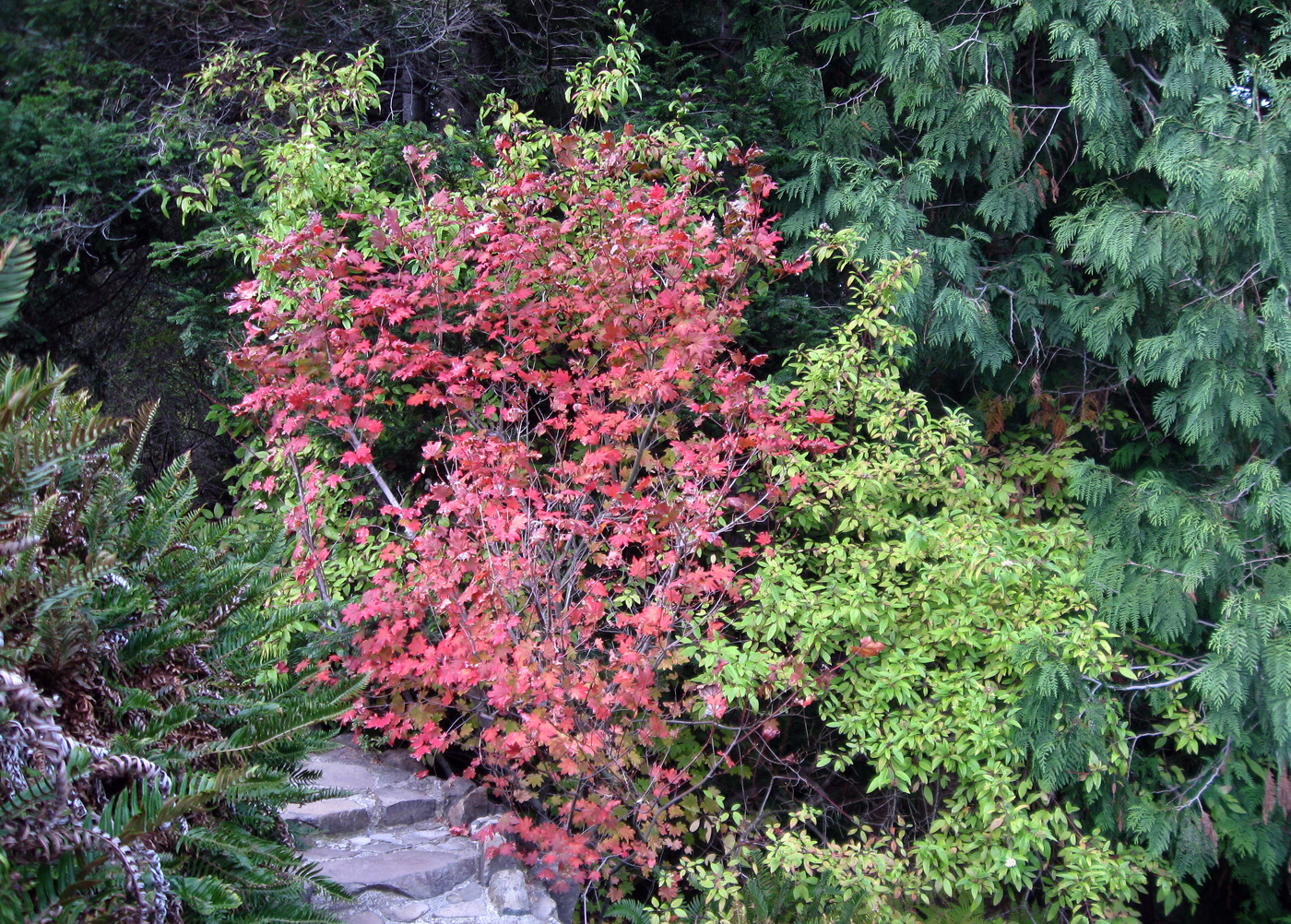 |
| Vine maple fall color at Tilden Botanic Garden in Berkeley CA, photo courtesy of drystonegarden.com |
Usually what they mean is a Japanese maple (Acer palmatum), like a Coral Bark Maple or a Laceleaf Maple. Sometimes they are interested in an upright, larger species like the taller Japanese varieties, or even a Red Maple (Acer rubrum). Most folks don't have room in the yard to even consider our Northwest native Bigleaf Maple (Acer macrophyllum).
More often than not, after determining their specific goal-- color? shade? accent tree?-- my answer is to suggest the coastal native Vine Maple, Acer circinatum.
Other maples will grow here, given sufficient moisture, good drainage and shelter from wind. And I do mean shelter from wind. A coastal gardener might plant a perfectly good Willamette-Valley-grown nursery tree, like an upright Japanese maple, only to see it defoliate on one side, lean away from prevailing winds, leaf tips turning brown and crispy in mid-summer and finally an early drop of sad brown leaves without any fall glory.
One of the primary features sought after when choosing a maple tree is that amazing display of fall color. Depending on the species, it may range from a solid golden showing to a blazing range of sunset hues. So it's pretty disappointing when your maple goes from summer green to dead brown all in one shot. Partly this is due to the climate, since great fall color is a combination of sunny weather and cold night temps.
This is where Vine Maples really shine. Since they are adapted to our mild climate, it takes little of the cold fall air to bring on the color. Even within the city limits of Lincoln City, several blocks from the ocean, the Vine Maple is capable of a display including reds and yellows, and lasting several weeks.
Entering winter we enjoy another fine feature of this tree, the lovely mottled grey-and-white smooth bark. (Young trees have greener bark that improves with age). The bark is best displayed by using an upright pruning style, with the usually multi-trunked Vine Maple cleared of lower branches and excess root suckers. Allow the upper canopy to spread with just occasional thinning as needed for light and wind passage.
Uses for this small tree include placement in tight or shady areas close to a structure or walkway. Because the canopy is fairly narrow, it can be easily pruned to arch gracefully over a path or the eaves of your house, without causing damage. Since the leaves are small (similar in size to Japanese maples) they make for easy cleanup in the fall and are not likely to cause clogged gutters like those of Bigleaf Maple. Underplanting a Vine Maple with spring bulbs or low-growing native plants including perennials is quite charming, and provides an opportunity to explore a shade-loving palette. Vine Maples are especially pleasing if they can be placed where afternoon sun can backlight the glowing leaves, and they are right at home beside a stream or "dry creekbed" landscape feature.
 |
| Vine maple is easily pruned in tight location |
Caring for a Vine Maple is simple on the central coast. They should be given some shelter from direct ocean winds, but can be used on the lee side of many homes near the oceanfront. Like most natives, they don't require fertilization if they are planted in average coastal topsoil, which tends to be high in organic matter and fairly acidic; if your soil is poor, dig a large hole and add compost to mix with the surrounding soil.
Provide your Vine Maple with a little supplemental water (once a week is plenty) in the dry months of late summer, especially when it's getting established the first couple years. Prune as desired for shape, but please don't top this tree-- it will spoil the structure. Sit back and enjoy your fine native tree.
Resources for Vine Maples: On the central coast, Blake's Coastal Nursery and Landscape in Gleneden Beach (Loop Rd., exit just south of Salishan, continue into Gleneden and Blake's is on the left hand side).
In the Willamette Valley, my favorite for natives is Wallace Hansen's nursery in Salem, which is unfortunately closed at this time but the website offers loads of information on native plants, for free. Take a look. Most nurseries in the Valley that carry trees of any kind will offer Acer circinatum.



